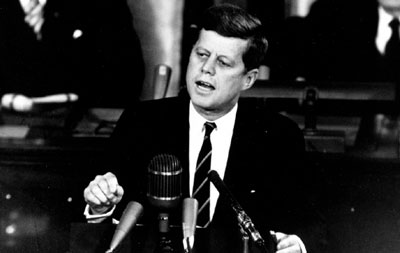Kennedy versus Obama on spaceby Michael Huang
|
| Even if foreign competition is ignored, there are still strong inherent reasons why human spaceflight should be fully supported as part of a space program that puts both robots and humans in space. |
The policy changes that Senator Obama is proposing will have political consequences for the presidential election. Aerospace workers in the decisive state of Florida will be unhappy with his five-year delay and his ambiguous opinions about human spaceflight in general. This is during a time when the Kennedy Space Center in Florida is facing its most far-reaching changes since the Apollo-Shuttle transition of the 1970s. (Related changes at the Johnson Space Center in Texas may affect congressional elections there.)
It could be argued that “Kennedy versus Obama” is inappropriate because what was right in the 1960s is not necessarily right in the 2000s. President Kennedy was in the middle of the Cold War and the Space Race, and these rationales do not exist in 2008 (although the space activities of China, India, and other nations have been described by some as a new space race). But even if foreign competition is ignored, there are still strong inherent reasons why human spaceflight should be fully supported as part of a space program that puts both robots and humans in space.
An editorial in The Times of India has an insightful summary of the reasons for robotic and human spaceflight. Mukul Sharma writes that one of the goals of NASA’s scientific program is to discover extraterrestrial life, or conditions favorable to extraterrestrial life. Life is also central to the rationale for human spaceflight. Establishing permanent stations, bases, or colonies for human life—allowing humankind to live on new worlds—can only be done with both humans and machines.
Human life cannot be automated and replaced by machines (unless someone invents a machine with human intelligence and sentience, in which case all humans, on Earth and in space, can become obsolete together). On the other hand, human work should be automated when it is possible and advantageous to do so.
Confusing human life and human work has led to some bad arguments against human spaceflight. The sociologist Amitai Etzioni, who has been arguing against human spaceflight since 1964 (The Moon-Doggle), opens a 2003 essay by saying that NASA should be more like the Air Force. Etzioni was making the point that the Air Force is increasingly using remote-controlled, unmanned drones instead of piloted aircraft, and that NASA should do the same with its space activities.
It’s a persuasive argument, but Etzioni is comparing military aviation with civil spaceflight. A more relevant analogy is to compare civil aviation with civil spaceflight. This is where Etzioni’s argument falls apart, because no amount of arguing will convince Boeing and Airbus to replace their jumbo jets with unmanned drones. They may replace the pilot with a machine one day, but nothing will replace the human passenger.
| If Senator Obama is serious about bipartisanship, mending divisions between the left and the right, and charting a centrist course, his campaign should revisit his space (and education) policies. |
This applies to other fields as well. The quest for a robotic car, as pursued by DARPA and others, will result in driverless vehicles. If they happen to be transporting cargo, they will be completely unmanned. If they are carrying passengers then they will be manned but driverless. Home automation is another example. The functions of the home are automated, but removing the human occupants would make the whole thing pointless. In all these fields, work is being automated, the work of pilots and drivers. Etzioni is essentially arguing that we should also automate the passenger—automate human life. The automation of passengers does not make sense on Earth or in space.
The popular “humans versus robots” debate is a false dichotomy when it only offers two sides of the debate. The third option, both humans and robots, is clearly the best resolution. The general election campaign sees both presidential candidates moving towards the political center. The center of space politics is to support both human and robotic spaceflight. If Senator Obama is serious about bipartisanship, mending divisions between the left and the right, and charting a centrist course, his campaign should revisit his space (and education) policies. Running punitive measures against human spaceflight may appeal to Bob Park or Amitai Etzioni, but for most people it is unnecessarily divisive and controversial.
